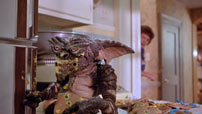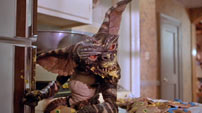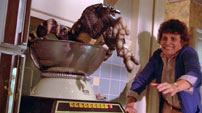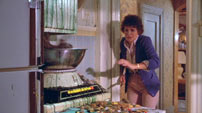|
 |
|
 |
|
 |
 |
| |
16:9 in English: Gremlins in the Mix
Af ETHAN DE SEIFE
“I don’t think one movie has to be a certain type of movie,” Joe Dante has said. “In order to be interesting, movies have to cross genres.” Dante has made a career of interesting movies which cross genre lines. An investigation into the blending of the horror and comedy genres suggests that there’s more to Gremlins than meets the eye.
Joe Dante’s film Gremlins was the fourth-highest-grossing film of 1984, and Warner Bros.’ “biggest pre-Batman grosser” (Leayman 1990, p. 58), pulling in nearly $150 million at the U.S. box office in its initial release (Box Office Mojo) (1). Its success set the stage for a bizarre, underrated, one-of-a-kind sequel; at least three videogame adaptations; and merchandise of every imaginable stripe (2). Yet the film is best remembered for its special place in the history of movie ratings: Gremlins, along with Indiana Jones and the Temple of Doom – Steven Spielberg productions both – are generally cited as the films which sparked the creation of the somewhat equivocal “PG-13” rating.
Watchdog groups cited Temple of Doom’s famous scene of five-finger cardiac extraction and Gremlins’ death-by-microwave incident as examples of violence gone too far in films ostensibly marketed to young audiences. Anthony Breznican, in an article on the 20th anniversary of the introduction of the PG-13 rating, summarizes the matter neatly: “The flaw in the Motion Picture Association of America's rating system was that it lumped all children – from infants to 17-year-olds – into the same group.” (Breznican 2004) Ultimately, the addition of the new rating classification was an economic decision: the tremendous box-office success of Gremlins and Temple of Doom ensured that Hollywood would make more such films; PG-13 merely provided a shiny, new, parent-friendly box for them to fit inside (3). Dante himself, in one of the commentary tracks on the “Special Edition” DVD of Gremlins, refers to the new rating as a “stopgap” and “a lifesaver for a lot of pictures.”
Gremlins does indeed offer something for the littlest kids (cute, fuzzy, giant-eyed Gizmo), something for teens in search of gross-out effects (oozing cocoons, nasty mutilations, flaming and decomposing Gremlins), and even for savvy adults: here, as in most of his films, Dante offers sly satire on consumerism and a delightful stew of admiring-yet-acerbic pop-cultural references (Chuck Jones’s and Steven Spielberg’s cameos, the abandoned AMC Gremlin in the opening scene, the knowing quotation of It’s a Wonderful Life [1946], Invasion of the Body Snatchers [1956], and even Hemo the Magnificent [1957]).
That the film was designed to appeal to many types of audiences was surely a smart business decision. Executive producer Steven Spielberg is as astute a populist filmmaker as Hollywood has ever seen; it was precisely his desire to produce fantastical movies with wide appeal that triggered the shift in US film ratings discussed above. Gremlins, however, is not only an important film because of the ways in which it influenced MPAA politics, or because it made a lot of money, or because it is as well-made a piece of popular entertainment as one is likely to find: it is, without doubt, a very skilfully made film. Gremlins is important because of these things, but also because it robustly demonstrates the power and the capacities of genre in film. |
|

Fig. 1. Joe Dante and friend. The Dante quote is from Klein (2000). Foto: Videowatchdog
(1) For 1984, Gremlins is behind only Beverly Hills Cop, Ghostbusters, and Indiana Jones and the Temple of Doom.
(2) My most fondly remembered cog in the great Gremlins merchandising machine was Gremlins-brand cereal (or, more specifically, its commercial), which, though long absent from supermarket shelves, lives yet on the internet (last visited 12 January 2008).
(3) The PG-13 experiment (the idea for which Spielberg takes sole credit, incidentally; see Breznican 2004) became something of a catch-all category. For the better part of the two decades since its inception, studios aimed squarely for the PG-13 rating, since it allowed for the inclusion of a certain amount of the sex and violence that sells tickets, while implying to parents that the films were still more or less appropriate for most children. |
|
| |
At the level of film history and industry, Gremlins emerges from filmmaking practices in which genre mixing was de rigueur. We may understand Gremlins’ multiple levels of audience appeal as a function of the way in which it sits astride and happily commingles two genres, each with its own traditions and conventions: horror and comedy (4).
Roger + Steven + Werewolves = Gremlins
Asked about the source of his career-long interest in blending horror and comedy, Joe Dante responded, “I don’t know where it comes from … it comes from me, I guess … it’s the way I see the world.” (Singer 1998, p. 58.) Setting aside for the moment the banality of asking an artist where he gets his ideas, and granting that no one knows this particular answer better than Dante himself, it is nevertheless important to acknowledge the influence of Roger Corman and his American-International Pictures (AIP).
One of the most prolific American filmmakers (nearly 400 producing and 55 directing credits to date [Internet Movie Database 1]), and surely one of the most significant influences on Hollywood film since the mid-1950s, Corman is principally known for his thriftiness (to put it charitably), for his gleeful explorations into the cross-breeding of genres (about which more below), and for the fact that he developed and encouraged a large body of highly talented filmmakers who, between them, have entirely changed the face of American filmmaking: Martin Scorsese, Jonathan Demme, Ron Howard, Jack Nicholson, John Sayles, Gale Ann Hurd, and Francis Ford Coppola, to name a few. Joe Dante also graduated from the Corman school of filmmaking.
The titles of AIP films from the ‘50s and ‘60s may sound like those of cut-and-dried horror/exploitation pictures – The Brain Eaters (1958), A Bucket of Blood (1959), The Wasp Woman (1960) – but the films themselves were always intended to be comic, as clearly evidenced by, for instance, some of A Bucket of Blood’s taglines: “A comedy of errors! A comedy of terror!” and “The picture that’ll make you sick, sick, SICK with laughter!” (Internet Movie Database 2) These films not only took their genre identities lightly, but served as vehicles for the savvy satire of such pop-cultural phenomena as beatniks, youth culture, and film genres themselves – a tendency that would become quite pronounced in Dante’s own films.
Roger Corman felt he was creating a new kind of genre with such films as Bucket of Blood and Little Shop of Horrors. He termed it “the black-comedy horror film” (Corman 1990, p. 61). Nevertheless, the blending of horror and comedy was not invented within the cardboard walls of AIP. A random dipping into nearly any decade in American film history pulls up such films as The Bat (1926), The Old Dark House (1932), Dean Martin’s and Jerry Lewis’s Scared Stiff (1953; itself modeled on the 1940 horror-comedy Bob Hope vehicle The Ghost Breakers), the series of films in which Abbott and Costello meet Frankenstein, Boris Karloff, The Invisible Man, Dr. Jekyll and Mr. Hyde, and The Mummy (1948, 1949, 1951, 1953, and 1955, respectively), The Fearless Vampire Killers (1967), and The Abominable Dr. Phibes (1971). Significantly, these were the very types of films which Dante saw as a youth; just as significantly, the studio that gave him his entrée into the film industry was a studio which was fully invested in just these kinds of cross-pollinated genre films.
Dante, after editing and directing several Corman films in the 1970s, got his big break with The Howling (1981), a highly intelligent werewolf picture (in which Roger Corman has a cameo role) that lampooned both werewolf pictures and horror films in general. In Joe Dante’s words, he and co-screenwriter John Sayles wanted to make “a kind of modern, more urban, and somewhat more sophisticated werewolf picture” (Ehrenstein 1995, p. 52). |
|
(4) At least two generic traditions: Dante himself, in the actors’ commentary on the Special Edition Gremlins DVD, says that the film is at least partly a work of science fiction, as well. |
|
| |
Sayles’ and Dante’s method of sophistication was to add humor to the mix, and The Howling is funny; surely its title refers not only to lycanthropic baying but to the sense of “howler” as in “very funny joke.” The film’s happy-face motif (in which one of the ubiquitous, yellow, smiling-face stickers of the 1970s indicates the presence of werewolves; Fig. 2 ) is a perfect condensation of its generic stance – and it is no coincidence that one of these stickers shows up in Gremlins, also as an indication of a horrific transformation (fig. 3).
Dante’s canny combination of horror and comedy in both The Howling and a previous Corman film, Piranha (1978), attracted the attention of one Steven Spielberg, a rising young producer-director who tapped Dante to direct Gremlins, a Chris Columbus script which he had purchased, and which would become the third film produced by Spielberg’s Amblin Entertainment production company. With its mandate to mix genres firmly in place, Gremlins at once looks back on the low-budget cross-genre pictures of the 1960s and ‘70s, and looks ahead to a Hollywood dominated by people like Spielberg, Coppola, and Scorsese, all of whom have made – and continue to make – films which combine genres, films which celebrate maligned genres, films which deliberately invert and subvert established genres. Its place in film history, in other words, can be determined, in part, by the ways in which it combines its two central genres.
Gremlins Surprise, à la Dante
In a number of interviews, Dante has spoken of his intention to keep viewers of his films surprised: “[T]here's this tyranny of letting the audience decide what it thinks it wants to see. The audience doesn't know what it wants to see. The audience wants to be surprised. It wants to be entertained. They don't want to dictate that all stories must have a happy ending.” (Klein 2000)
One level on which Dante has achieved his desired quotient of surprise is that of moment-to-moment unpredictability. This is, after all, a filmmaker who has had a hand in making such laff-a-minute works as “Police Squad!,” (1982) Amazon Women on the Moon (1987), Hollywood Boulevard (1976), and the epic, seven-hour assemblage of trailers, B-movies, and cinematic ephemera that is The Movie Orgy, aka Cheeseburger Film Sandwich (1968).
On another level, however, the “surprise” that Dante refers to comes in the form of the combination of genres, behind which technique lurk some interesting notions about the very nature of spectatorship.
Interviewed by David Ehrenstein, Dante has spoken about the dilemmas of making genres films; his response is worth quoting at length, as it indicates the real, moment-by-moment decisions that genre filmmakers have to make.
In genre pictures, the audience tends to be one step ahead of the plot … because we’ve all seen the plot. And one of the fun things about going to see certain kinds of movies is to see the story unfold because we’ve proven to ourselves that we like to see that kind of thing unfold. But that doesn’t mean you have to just sort of reverentially go through all the clichés that are always used. … The idea was that the Gremlins were supposed to take over the movie and sort of destroy it while it was on. So it has to start out as a prosaic kind of regular movie in order for it to be subverted. (Ehrenstein 1995, pp. 53-54)
Such observations highlight the paradox at the heart of genre filmmaking: adhere strictly to convention, and get branded as someone who merely goes through the motions; subvert convention entirely, and suddenly you are no longer making a genre film at all. |
|

Fig. 2. Dee Wallace spies a lycanthropic happy face in The Howling.

Fig. 3. The return of the happy face in Gremlins. |
|
| |
The first version of the script for Gremlins was, apparently, far more grisly than the one that was produced. In the finished film, Barney, the dog belonging to the main character, Billy, is strung up with Christmas lights from the eaves of a house; in the original script, Barney is killed and eaten by the Gremlins. In the film, Billy’s mother successfully defends herself against the Gremlins who have invaded her kitchen, killing several; in the original script, the Gremlins not only kill Billy’s mother but slice off her head and bounce it down the stairs (5) (More on this key scene below.) Had these murders appeared in the film, Gremlins could only have belonged to the horror genre. Instead, both encounters are played for comedy: it may be only a mild sight gag to show a dog dangling from strands of multicolored electric lights, but the scene in which Mrs. Peltzer messily slays Gremlins with kitchen appliances is one of the film’s comic highlights.
Between Adherence and Irreverence
Gremlins occupies a happy medium between slavish genre adherence and utter irreverence, a fact which suggests that Dante’s ideas about surprising the audience are actually quite vital to successful genre films. The things we expect from a horror film – suspense, shock, terror, violence, gore, fear – are present, and this satisfies the pleasure we feel when we understand that a key signpost has been reached: it is quite the same thing as the satisfaction we feel when the melody introduced in a pop song’s verse is resolved in the chorus. But certain elements which we may not have expected are scattered throughout the film, and these satisfy a different kind of pleasure: the pleasure we feel when we encounter a refreshing variation on a familiar idea.
By combining elements from both horror and comedy, Gremlins satisfies genre expectations, audience expectations, and studio expectations at a single turn. It should come as no surprise that the film found a large audience, made a great deal of money, and begat both a sequel and a decent-sized merchandising industry. As suggested above, Gremlins is everything that a popular film should be, an achievement it reaches largely through its keen understanding of genre identity and manipulation.
Little Green Men
The above sections suggest the “macro”-scale ways in which the combination of genres shapes Gremlins. Genre-mixing is also a key determinant in the stylistic systems of the film: the patterned uses of cinematography and editing, for example. Through an analysis of certain “privileged” scenes, we may observe how, on a minute, moment-by-moment level, the blending of genres shapes the material texture of the film.
What are these privileged scenes, and how have they been identified as such? Simply, these are scenes in which the combination of horror and comedy is most explicit; the scenes whose overall tones are most clearly mixed: those which depict horrific moments but present them in comic ways, or depict comic moments using techniques borrowed (perhaps “quoted” is a more apt term) from the horror film. A few such scenes stand out quite prominently; I take them to be the most important scenes in the film.
The first – and arguably most important – of these scenes is that in which Mrs. Peltzer is harassed by and ultimately kills several Gremlins in her kitchen. The narrative situation is that Billy, the film’s protagonist, has mistakenly fed some Mogwai after midnight. Overnight, the Mogwai enter a pupal stage, and emerge from their gooey cocoons as malicious Gremlins. Several of these Gremlins descend from Billy’s attic bedroom to the kitchen in the Peltzer house, where they attack Mrs. Peltzer. This is the “reveal” of the creatures: our visual introduction to the Mogwai’s evil alter ego.
As the scene begins, Mrs. Peltzer receives a phone call from Billy, warning her to get out of the house. A cutaway shows a scaly, green, clawlike hand yanking the cables out of the telephone box, and the line goes dead. The first hint of the Gremlins’ monstrous physical form is quickly followed by a hint of the weird mischief they will wreak: from the living room comes the incongruous sound of Johnny Mathis’s version of “Do You Hear What I Hear?” – these are Gremlins who will not only try to kill us, but who will try to annoy us with syrupy, overplayed Christmas music. |
|
(5) Dante mentions Columbus’s first draft of the script in both the DVD commentary and the Klein interview. |
|
| |
The creatures are revealed gradually, in classic horror-film fashion, but Dante undercuts the horror with moments of humor. When a knife-wielding Mrs. Peltzer turns off the music, we can see Gremlin-prints in the dust on the receiver; the next sign we get of the Gremlins is a shadow on the wall. By this point in the scene, we have seen isolated fragments of the creatures’ bodies, and the physical evidence of their presence, but not the creatures themselves. Dante shows Mrs. Peltzer’s stealthy approach into the kitchen with a shot that starts by framing her in medium-long shot in the doorway (fig. 4), and then tracks backwards into the kitchen to provide our first full glimpse of one of the Gremlins, who sits on a countertop. The camera tracks for about ten seconds before settling into place; over the course of these ten seconds, the movement of the camera causes the Gremlin to move into frame from the left edge, until we can see almost its entire body – the first time in the film we see a Gremlin in its entirety. (Fig. 5) Just as important as the camera movement is the change in focal length: as the camera moves backward, the focus shifts from Mrs. Peltzer (who hides behind a wall) to the Gremlin. The combination of camera movement, framing, and change in focal length ensure that our attention is now firmly focused on the creature.
The “reveal” of the Gremlin is handled in much the same way as it would be in a straight horror film: hints at the creature’s existence lead to glimpses of small parts of the creature’s physical form; eventually, by following the actions/glances of one of the protagonists, these hints and glimpses give way to a full, unadulterated shot of the creature, in order to demonstrate its horrific nature. (This is, for instance, precisely the manner in which the creature is revealed in Matt Reeves’s Cloverfield [2008].) Dante does all this, but undercuts it by having the Gremlin gnawing off the head of a gingerbread man: a sick little joke that foreshadows the comic grotesquerie which is soon to follow. |
|

Fig. 4. Gremlin revealed, Stage 1.

Fig. 5. Gremlin revealed, Stage 2. |
|
| |
In the last frames of this shot, the frosting-smeared Gremlin cocks its ear, grimaces, and says “Yum yum” – is it enjoying the cookie, or does it want to consume Mrs. Peltzer, too? (fig. 6) Mrs. Peltzer, however, turns the Gremlin into cookie batter before it can eat her: as it dives headfirst into the bowl of the Peltzer electric mixer, one of the many malfunctioning devices which her husband invented, she enters the room and purées the critter (fig. 7). In a neat variation of the earlier tracking shot, Dante uses a nearly identical composition – sans Gremlin – to show Mrs. Peltzer turning off the blender (fig. 8); just as neatly, the yellow cookie frosting which was all over the Gremlin’s face is echoed in the Gremlin’s innards that are now splattered all over the cookies. Here, a running gag about Mr. Peltzer’s malfunctioning inventions receives gruesome payoff in the form of Gremlin guts all over the kitchen: an echo of an earlier gag in which the Peltzer Peeler-Juicer sprays orange pulp all over the kitchen, and one of the film’s key moments of the blending of comedy and horror.
What is, in many ways, the film’s defining moment occurs in this scene, as well: the explosive microwaving of another Gremlin, which first receives a thorough dousing with flea and tick spray like the pest that it is. (Of special note is the microwave’s cheery “Ding!” to announce that the dish inside is finished.)
The balance between comedy and horror structures this scene at the level of the stylistic choices Dante employs: camera movements, racking focus, mirrored compositions. Even mise-en-scène elements like the blender and the icing/ooze fit into this careful structure; a third key prop, a Christmas tree, is activated moments later when a Gremlin hiding in it lunges at Mrs. Peltzer, a moment that echoes an earlier gag in which Billy’s friend Pete, dressed as a Christmas tree, stumbles ungracefully into the Peltzer living room. This, then, taps into one of the film’s main tropes, which is the source of many of the film’s wry, part-horrific/part-comic gags: that the Gremlins are us – or, rather, that they are reflections of human beings’ worst tendencies.
The doubling of the “figure inside the tree” gag hints at this theme, which receives its fullest treatment in another of the film’s privileged scenes: the destruction of Dorry’s Tavern. Apparently, the filming of this scene was also something of a turning point in the creation of the film’s tone and generic identity, as Dante suggests in an interview: “[W]hen we were making the movie, it just seemed that they were actually so funny – the puppets were so funny when they were doing human things, putting on clothes – that it took a whole different direction. It became much more of a horror-comedy than it was a straight horror picture.” (Klein 2000)
Dorry’s Tavern
At Dorry’s, Gremlins drink heavily, smoke to excess, gamble (and cheat at cards), pick their noses, expose themselves, and beat and kill each other without a second thought. To emphasize the Gremlins’ unpleasant behavior, Dante organizes it into a kind of catalogue: fairly quick cuts from one shot of Gremlin depravity to another. The scene takes place over 4 minutes, 22 seconds, and contains 72 shots, for an average shot length of about 3.6 seconds: fairly quick. (This figure is diminished considerably by a short montage of a Gremlin breakdancing, a moment which highlights Dante’s eagerness to satirize the fickle nature of American popular culture: Gremlins, those vicious bottom-feeders, love a silly fad even more than do American teens.) The result of this editing pattern is that the scene is broken into isolated chunks, gags, or setpieces: moving quickly from one to the next impresses upon us the large number of comically repulsive behaviors of which these murderous monsters are capable. Again, the implications of the film’s generic identities are far-reaching. |
|

Fig. 6. Gremlin revealed, Stage 3. ”Yum yum”.

Fig. 7. Gremlin purée.

Fig. 8. Kitchen carnage. |
|
| |
The stylistic effects of the comedy-horror mixing permeate the film, and can be found at nearly every level. Other, isolated instances include the moment when Stripe, the leader of the Gremlins, playfully “cannonballs” into the pool at the local YMCA, and holds his nose on the way to the bottom (fig. 9): a humorous way of emphasizing the malicious chaos about to ensue. Gremlins multiply when they get wet, so the nose-holding may be funny, but it signifies the taking of Kingston Falls by the Gremlins.
In a later scene, shot composition becomes a tool of horror-comedy in the scene in which Gremlins kill Mrs. Deagle, Kingston Falls’ version of It’s a Wonderful Life’s Mr. Potter. The shot in which Mrs. Deagle’s motorized stair-chair, with which the Gremlins have tampered, shoots through a second-story window (fig. 10), and the subsequent shot of the dead and still-chairbound Mrs. Deagle lying in the snow (fig. 11), are framed in such a way as to emphasize not just the horror of her violent death, but also the cartoonish implausibility of her defenestration and such darkly comic touches as the fuzzy slippers which somehow remain on her feet. The Deagle scene is also important because it gives our first glimpse of Gremlins dressed as humans (Christmas carolers!), and because it fits complicatedly into the theme of Gremlins representing humanity’s worst traits. Mrs. Deagle is a malicious woman who wants to have Barney euthanized, refuses assistance to destitute families, and intends to tear down cherished Kingston Falls landmarks like Dorry’s Tavern. That she is killed by Gremlins seems like just desserts, but, then, it is also a case of replacing a small evil with a larger one. The film is uncomfortably ambivalent about Mrs. Deagle’s murder – part of the reason that this scene is another of its privileged moments: it exists somewhere between comedy and horror, a fact emphasized, again, in shot composition.
Final Remarks
“I think … the relationship between horror and comedy is a very interesting one,” Dante has remarked. “I think the two are very connected.” (Valeriote 1998, p. 72) Dante’s films bear out his statement, none perhaps as thoroughly as Gremlins. Later films, such as The ‘burbs (1989), Gremlins 2 (1990), and Small Soldiers (1998) downplay horror in favor of satire, a tendency which was always present in Dante’s work but which has emerged so fully in recent years – in films such as the made-for-cable Homecoming (2005) and The Screwfly Solution (2006) – that a recent article refers to him as “America’s sharpest satirist.” (Peranson 2006, p. 6)
This is simply to say that the combination of comedy and horror does not fully explain away either Gremlins or its director. The claims here are more modest: that a consideration of the way the film straddles two genres allows for a deeper and richer understanding of what has proven to be, against steep odds, one of the more durable and interesting American films of the 1980s. Gremlins is, perhaps, a more complex film than it appears to be, though it has also never ceased to be anything less than immensely enjoyable, in part precisely because of these forays into genre mixing. |
|

Fig. 9. “Stripe”’s cannonball humorously hints at the carnage to come.

Fig. 10. The defenestration of Mrs. Deagle.

Fig. 11. Slippers in the snow. |
|
 |
 |
 |
 |
 |
|
 |
 |
 |
| |
Facts
Ethan de Seife is currently Visiting Assistant Professor of Film Studies at Gettysburg College in Pennsylvania. His first book, This Is Spinal Tap, has recently been published by Wallflower Press; his forthcoming book on the films of Frank Tashlin will be published by Wesleyan University Press. This is his second article for 16:9.
Literature
Box Office Mojo 1984 Yearly Box Office Results (last visited 12 January 2008).
Breznican, Anthony. “PG-13 remade Hollywood ratings system,” Seattle Post-Intelligencer, 24 August 2004, available online (last visited 12 January 2008).
Corman, Roger; with Jim Jerome. How I Made a Hundred Movies in Hollywood and Never Lost a Dime (New York: Random House, 1990).
Ehrenstein, David. “Joe Dante and The Howling” in Jerry Roberts and Steven Gaydos, eds., Movie Talk from the Front Lines: Filmmakers Discuss Their Works with the Los Angeles Film Critics Association (Jefferson, N.C: McFarland & Co., Inc., 1995).
Internet Movie Database (1) page on Roger Corman, last visited 19 January 2008.
Internet Movie Database (2) page on taglines for Bucket of Blood, last visited 20 January 2008.
Klein, Joshua. “Joe Dante,” The Onion A.V. Club, 29 November 2000. Available online, last visited 20 January 2008.
Leayman, Charles. “Dante’s fun but always suggests an undertow of genuine horror,” Cinefantastique, Vol. 21, No. 3 (1990), p. 58.
Peranson, Mark. “Dante’s Inferno: The Necessary Satire of Homecoming,” Cinema Scope, Issue 25 (Winter 2006).
Singer, Michael. “Joe Dante,” in Michael Singer, ed., A Cut Above: 50 Film Directors Talk about Their Craft (Los Angeles: Lone Eagle Publishing, 1998), p. 58.
Valeriote, Catherine. “Joe Dante: Son of the Saturday Matinee,” DGA Magazine, Vol. 23, No. 2 (June/July, 1998). |
|
|
|
|
 |
 |
 |
 |
16:9 - februar 2008 - 6. årgang - nummer 25
Udgives med støtte fra Det Danske Filminstitut samt Kulturministeriets bevilling til almenkulturelle tidsskrifter.
ISSN: 1603-5194. Copyright © 2002-08. Alle rettigheder reserveret. |
11 |
|
|
 |
 |
|
|